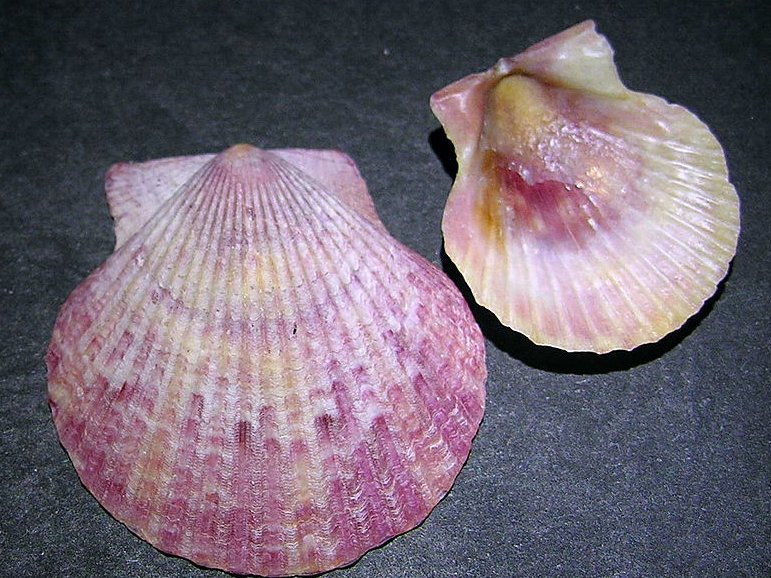So the so-called 'Moon calendar' is not truly a Moon calendar. Instead it is basically more likely a description of an important part of the cycle of the year. Here (at equinox) Raven found a clam with living beings inside:  It was lying on the sandy pristine beach ... Raven gazed up and down the beach. It was pretty, but lifeless. There was no one about to upset, or play tricks upon. Raven sighed. He crossed his wings behind him and strutted up and down the sand, his shiny head cocked, his sharp eyes and ears alert for any unusual sight or sound. The mountains and the sea, the sky now ablaze with the sun by day and the moon and stars he had placed there, it was all pretty, but lifeless. Finally Raven cried out to the empty sky with a loud exasperated cry. And before the echoes of his cry faded from the shore, he heard a muffled squeak. He looked up and down the beach for its source and saw nothing. He strutted back and and forth, once, twice, three times and still saw nothing. Then he spied a flash of white in the sand. There, half buried in the sand was a giant clamshell. As his shadow fell upon it, he heard another muffled squeak. Peering down into the opening between the halves of the shell, he saw it was full of tiny creatures, cowering in fear at his shadow ...
The Chinese had their name Chang Sha (the Long Sand-bank) for the star inside (ki roto ki) the 'square' of Raven (ζ Corvi) - 'almost on the limit of invisibility' and thus demanding an eye sharp as a Raven's. There could be a joke here. 'Zaiyn' (ζ) makes me remember a curious fact about ravens, they have no external penis: ... Zayin (also spelled Zain or Zayn or simply Zay) is the seventh letter of many Semitic abjads ... It represents the sound [z]. The Phoenician letter appears to be named after a sword or other weapon. (In Biblical Hebrew, 'Zayin' means sword, and the verb 'Lezayen' means to arm. In modern Hebrew, 'zayin' means penis and 'lezayen' is a vulgar term which generally means to perform sexual intercourse and is used in a similar fashion to the English word fuck, although the older meaning survives in 'maavak mezuyan' (armed struggle) and 'beton mezuyan' (armed, i.e., reinforced concrete). The Proto-Sinaitic glyph according to Brian Colless may have been called ziqq, based on a hieroglyph depicting a 'manacle' ... I tried to find my source but without success. However, the following Wikipedia text supports my memory: "In the Talmud, the raven is described as having been only one of three beings on Noah's Ark that copulated during the flood and so was punished. The Rabbis believed that the male raven was forced to ejaculate his seed into the female raven's mouth as a means of reproduction." This perspective - Raven and Clam - may have been shared by Metoro and we could then understand his te marama noho i te nohoga as a way to say how 'light' (= life), te marama, was 'sitting waiting' (noho) inside its 'residence' (= shell), i te nohoga.
Metoro gave a similar explanation at a similar glyph a week later:
The Clam, we should remember, had a fundamental part to play in Polynesian mythology: ... A very detailed myth comes from the island of Nauru. In the beginning there was nothing but the sea, and above soared the Old-Spider. One day the Old-Spider found a giant clam, took it up, and tried to find if this object had any opening, but could find none. She tapped on it, and as it sounded hollow, she decided it was empty. By repeating a charm, she opened the two shells and slipped inside. She could see nothing, because the sun and the moon did not then exist; and then, she could not stand up because there was not enough room in the shellfish. Constantly hunting about she at last found a snail. To endow it with power she placed it under her arm, lay down and slept for three days. Then she let it free, and still hunting about she found another snail bigger than the first one, and treated it in the same way. Then she said to the first snail: 'Can you open this room a little, so that we can sit down?' The snail said it could, and opened the shell a little. Old-Spider then took the snail, placed it in the west of the shell, and made it into the moon. Then there was a little light, which allowed Old-Spider to see a big worm. At her request he opened the shell a little wider, and from the body of the worm flowed a salted sweat which collected in the lower half-shell and became the sea. Then he raised the upper half-shell very high, and it became the sky. Rigi, the worm, exhausted by this great effort, then died. Old-Spider then made the sun from the second snail, and placed it beside the lower half-shell, which became the earth. I guess the partially seen entity in Ca7-16 could represent 'the first snail' (the moon) and the one in front in Ca7-23 'the second snail' (the sun). The form of the night sky appears to be like a globe, while the form of the daytime sky can be imagined as having an apex at noon.
| |||||||||||||||||||||||||||||||||||||||||||||||||||||||||||||||||||||||||||||||||||||||||||||||||||||||||||||||||||||||||||||||||||||||||||||||||||||||||||||||||||||||||








